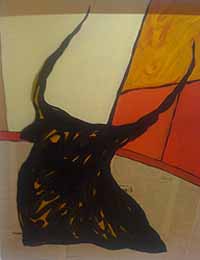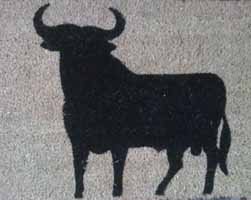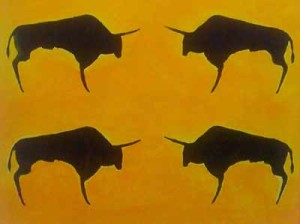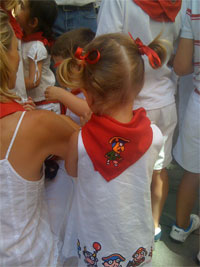About the Bulls
About this time very year I write a post about my annual escape to the north of Spain with my clan of girlfriends. I’ve recounted the rituals we re-enact every year when we go to the fiesta San Fermín in Pamplona. I’ve described the departure stress of the preparation to go, the bitter sweetness of the return from the fiesta, the feelings of joy and desperation that are both components of this week that I take for myself every year, when I attend one of the world’s hardest parties.

The one subject I haven’t addressed fully: the bulls. If I tell people that I am going to Pamplona, to the running of the bulls, I usually get a few raised eyebrows. Almost everyone has heard of the running of the bulls, although their understanding of it is more often incorrect, thanks ot the way it has been depicted, poorly, by Hollywood. If you want to see what it really looks like, click here.
For the record, I do not run with the bulls. I watch them go by from the safety of my balcony. They run down the street in front of where we always stay, and I can lean against the railing and watch the big, beautiful beasts, and thousands of runners, sprinting by my door.
And then there is the bullfight. I am not a strong advocate for the tradition of bullfighting, nor am I opposed to it. I am a guest in Pamplona for their fiesta – the city welcomes foreigners to attend, rather graciously as their town gets trashed from it – and I’ve never felt it was my place to enter the debate for or against the encierro and the bullfight. But I have learned a few things over the ten years that I have been going to Pamplona for their fiesta. I think there are some interesting facts to consider before dismissing it as cruel or unfair to the bulls.
1. The running of the bulls is an athletic tradition. The local runners train all year to be fit enough to run for even a few moments in the primo spot, just ahead of the horns of the bull, as it runs from the corral at the edge of the city to the bullring in the center. A number of foreigners join them, runners who come every year to do so, and they, too, take the activity seriously. These are people who, prior to running, took the time to talk to seasoned runners and to watch and learn how to do it well. They consider it a privilege to take part in the encierro, and try to do so safely and with respect to the local tradition. The drunk idiot backpackers who roll into town and drink all night and never bother to learn the cultural and safety codes of the event, they are not what the run is about. In fact, their ignorance of it is dangerous, and puts every runner, experienced or novice, at risk.

2. The bullfight is not a sport, it’s an art. As the Fiesta Nazi puts it, “it’s a tragic opera with three acts, and the hero has to die.” I have attended many corridas, and there is always blood and death; sometimes it is too much for me and I am compelled to look away. But when it is a good bullfight, when each player in the ring does his part with grace and accuracy, when the rapport between matador and bull is palatable, it is a beautiful dance. I have wept at a bullfight because it was so moving. When a torero can transmit this kind of emotion to the crowd, thousands of people in the ring share the awe of a poignant life and death moment. That’s what makes it opera, not a sport.
3. In a good bullfight, the bull does not know he is losing until the very end. The bull is provoked, he gets angry, and he’s celebrated for his fighting spirit. Again to quote the Fiesta Nazi, “in a bar fight, the guy that’s swinging isn’t saying ouch, don’t do that.”
4. For every bullfight there is a time limit. If the matador is unable to finish the fight within the given time, the bull will be removed from the ring and shot so that it does not endure an unnecessary and prolonged suffering. There are rules to protect the animals.
5. The bull leads the best life of any animal that is bred in captivity. They live in the open pastures and are treated as noble creatures. They are bred specifically to be aggressive and fierce. A bull breeder wants his bulls to do well in the fight, so these bulls, usually between four and six years old when they are ultimately led to the bullring, enjoy an existence that surpasses any animal that is raised (usually one year) for slaughter to become food on our tables. If you know even a little about the cruelty to animals in the meat industry and yet still eat meat, then a prejudice against the bullfight is a bit hypocritical. The bulls live a long, ideal life, and they are revered until the last moment of it.

In Spain – except Catalonia where it was banned – and in Latin America, the bullfight is a cultural tradition that has been practiced for centuries. That’s not necessarily the reason for it to continue. Female genital mutilation is a cultural tradition in some African countries as is the Muslim custom of hiding women behind a full body burqa, and I see good reasons to protest both. I can understand how it would seem to animal rights activists that the bullfight is a cruel tradition that should be protested.
But I like going to the bullfight. I like being in the corrida packed with expectant spectators, watching a 1000 pound muscled animal break out of the holding pen and run into and around the ring. I like the bright colors of the toreros’ traje de luces, their pink and yellow capote capes waving above the dusty floor of the ring, the elegant bursts of music from the corrida brass band and the roar of the crowd, the sandwich after the third bull, and in Pamplona, the costumes and antics of the peñas, the local drinking clubs, juxtaposing a sarcastic irreverence with the tense drama of the corrida. The bullfight may or may not seem ethical to some people, and sometimes I do find it troubling. But I go every chance I get.
Not long ago Short-pants drew a map of her ideal town. She named the streets and avenues after her best friends and favorite aunts. She imagined places for all her preferred activities: a theater, a knitting center, a library. Her map also included large, circular bull ring, which she named after the Fiesta Nazi. She showed it to some dinner guests one night, inspiring them to ask me about what it’s like to go to a bullfight. She listened to my response and chimed in before I could finish. “The bulls live the best life,” she said, “and they are loved by everyone in the ring before they die.”

I suppose this is how cultural traditions, and prejudices, are passed on. The imprint of our own opinions on our children is powerful. If they are educated to think on their own, they may reject our stances, for, against or neutral. If we limit their exposure to critical thinking, they are likely to parrot what we they have heard us say about what we believe. I don’t mind that Short-pants knows a few facts about bulls, even though she’s never been to a corrida, but I will never insist that she share my view. Someday I hope she and her sister will accompany me to a Pamplona, or elsewhere in Spain, to experience it all for themselves, so they can make up their own minds about the right or wrong of the bullfight.
But for now it’s still my escape, the running of the mom, away from children and the household responsibilities and into a week of delirious fun and oblivion, dancing, laughing, drinking, and yes, the running of the bulls.


July 5th, 2013 at 4:05 pm
Best assumption-breaking essay on the enciero and the fight I’ve ever read, thanks!
July 8th, 2013 at 4:17 pm
That was great, thank you.
kunyi
July 18th, 2013 at 2:58 am
You paint this beautifully.